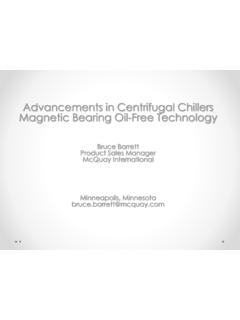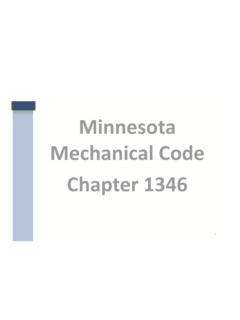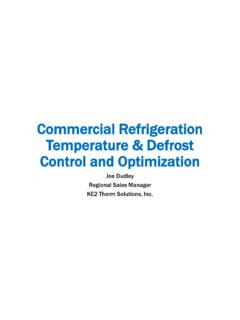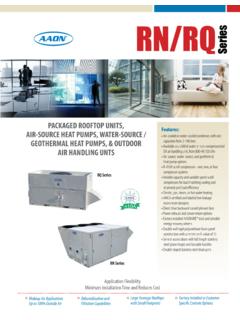Transcription of Optimizing Central Chilled Water Systems - MN ASHRAE
1 Optimizing Central Chilled Water SystemsKent W. Peterson, PE, FASHRAEP2S Engineering, Innovate AchieveInspire Innovate AchievePresentation Outline Foundation of CHW Plant Design hydronic System Design Chiller Fundamentals Optimizing Plant Performance Building Interfaces3 Inspire Innovate AchieveInspire Innovate AchieveFoundation of Design Why look outside the plant ? Understand how distribution system will operate Understand how CHW T will be effected by dynamics of the Systems connectedGOALD eliver CHW to all loads under various loadconditions as efficiently as possible4 Inspire Innovate AchieveInspire Innovate AchieveUnderstanding Loads & Their Impact on Design Overall plant capacity is determined by peak design load Cooling load profile describes how the load varies over time is needed to design the plant to stage efficiently5 Inspire Innovate AchieveInspire Innovate AchieveChilled Water Plant Efficiency Operating kW/ton achievable in today s plants (includes chillers, cooling towers and pumps) - - Good > Improvement Do you really know how your Chilled Water plants are performing?
2 Discussionon Hydronics7 Inspire Innovate AchieveInspire Innovate AchievePurpose of Pumping SystemsMove enough Water through the piping systemat the minimum differential pressurethat will satisfy all connected loads8 Inspire Innovate AchieveInspire Innovate AchieveUnderstanding Hydronics The pumping system will be required to operate under various load conditions Variable flow system differential pressures throughout the system will be dynamic hydronic Systems should be hydraulically modeled to design or troubleshoot complex systems9 Inspire Innovate AchieveInspire Innovate AchieveCaution Excessive pump head can cause Systems to not function as designed and waste considerable energy Pump Selection10 Inspire Innovate AchieveInspire Innovate AchieveSystem & Pump CurvesTotal FlowTotal Pressure11 hydronic FundamentalsVariable Flow System DynamicsVFDLoadLoadDP100 GPM5 PSID100 GPM5 PSID5 PSID28 PSID5 PSID2 PSID12 PSID38 PSID45 PSIDPUMPCLOSE LOADREMOTE LOAD206050403010070 PRESSURE PSIG12 hydronic FundamentalsVariable Flow System Dynamics100 GPM5 PSID0 GPM0 PSID5 PSID2 PSID12 PSID0 PSIDVFDLoadLoadDP12 PSID12 PSID19 PSIDPUMPCLOSE LOADREMOTE LOAD206050403010070 PRESSURE PSIG13 hydronic FundamentalsVariable Flow System DynamicsVFDDP100 GPM5 PSID0 GPM0 PSID5 PSID28 PSID38 PSID0 PSIDBAD SENSORLOCATIONLoadLoad38 PSID38 PSID45 PSIDPUMPCLOSE LOADREMOTE LOAD206050403010070 PRESSURE PSIG14 hydronic FundamentalsVariable Flow System DynamicsCONTROL VALVE PAT VARIOUS LOAD CONDITIONSCase 1 Full FlowCase 275% FlowCase 350% FlowCase 425% FlowCase 510% FlowBranch Flow (gpm)
3 10075502510 Branch P3838383838 Coil Valve Valve Innovate AchieveInspire Innovate AchieveBalancing ConsiderationsVariable Flow Systems Too large a balancing valve pressure drop will affect the performance and flow characteristic of the control valve. ASHRAE 2003 Applications Handbook, page Innovate AchieveInspire Innovate AchieveHydronic Pumping Conclusions Coil heat transfer is easier to control in low head (<50 ft) branches Remote, high head loads can be served more efficiently with variable speed series booster pumpingWhat You Must KnowAbout CHW T18 Inspire Innovate AchieveInspire Innovate AchieveCHW Temperature Differential Poor CHW T is the largest contributor to poor CHW plant performance To predict T, you must know: Characteristics of connected loads Control valve requirements and limitations Control valve control algorithms and setpoints Heat exchanger characteristicsChilled Water Coil CharacteristicsAssumes Constant LoadCHWS Temperature FCHWS Temperature FCHW T FCHW T F20 Inspire Innovate AchieveInspire Innovate AchieveFactors that Degrade TAssuming Coils are Selected for Desired T Higher CHWS temperature Poor control valves 3-way control valves 2-position valves on fan coil units Controls not controlling Setpoint cannot be achieved Valves not interlocked to close if load turns off21 Inspire Innovate AchieveInspire Innovate Achieve T Conclusions Design, construction and operation errors that cause low T can be avoided Other causes for low T can never be eliminated T degradation below design conditions is inevitable, therefore.
4 System design must accommodate the level of degradation anticipatedChiller Fundamentals23 Inspire Innovate AchieveInspire Innovate AchieveUnderstanding Refrigerant Lift Lift = SCT - SST Saturated Condensing Temperature(SCT) is dependent upon LEAVING condenser Water temperature Saturated Suction Temperature(SST) is based off of LEAVING Chilled Water temperaturePercent LoadedKW/tonCentrifugal Chiller without VFD1200T Low PressureCentrifugal Chiller with VFD1200T Low PressurePercent LoadedKW/tonPercent LoadedKW/tonCentrifugal Chiller without VFD1200T High PressureCentrifugal Chiller with VFD1200T High PressurePercent LoadedKW/tonCentrifugal Chiller ComparisonPercent LoadedKW/tonHigh PressureLow PressureConstant SpeedVariable SpeedOptimizing Plant Performance30 Inspire Innovate AchieveInspire Innovate AchievePrimary-Secondary vs Variable Primary Flow Variable primary flow plants can provide advantages over traditional primary-secondary configurations Less plant space required for VPF VPF is not conducive to CHW TES31 Inspire Innovate AchieveInspire Innovate AchievePrimary-Secondary Variable FlowPart Load Operation - 6000 Ton PlantLoad3000 Ton Load3000 Ton
5 Load58 F42 F54 FLoadLoadLoadLoadVFD P6000 GPM4500 GPM1500 GPM1500 tons1500 tonsOFF42 F32 Inspire Innovate AchieveInspire Innovate AchievePrimary-Secondary Variable FlowEffect of Low CHWR TemperatureLow T Syndrome44 F52 F42 F54 F6000 GPM7200 GPM1200 GPMA dditional chiller will need to bestarted to maintain the secondaryCHWS temperature setpoint if load increasesLoss of CHWS temp control1500 tons1500 tonsOFFLoadLoadLoadLoadLoadVFD P3000 Ton Load3000 Ton Load33 Inspire Innovate AchieveInspire Innovate AchieveVariable Primary FlowPart Load Operation - 6000 Ton Plant42 FCLOSED58 FVFD4500 GPMFM1500 tons1500 tonsOFFLoadLoadLoadLoadLoad PBypass is not needed if minimumflow through chiller is guaranteed3000 Ton Load3000 Ton Load34 Inspire Innovate AchieveInspire Innovate AchieveVariable Primary FlowEffect of Low CHWR TemperatureCLOSED54 FVFD6000 GPM1500 tons1500 tonsOFFFMLoadLoadLoadLoadLoad P42 F3000 Ton Load3000 Ton Load35 Inspire Innovate AchieveInspire Innovate AchieveSeries Arrangement In applications with high lift, a series arrangement will improve overall plant performance36 Inspire Innovate AchieveInspire Innovate Achieve85 F95 FSeries versus ParallelWith High Lift Requirement40 F56 FCH-1CH-240 F56 F40 F56 KW/tonParallel-Parallel37 Inspire Innovate AchieveInspire Innovate Achieve7% KW Reduction on Chillersor450 KW Reduction on 10.
6 000 ton Plant30 feet head increase on condenser Water would result in 230 KW increase in pump power220 Series versus ParallelWith High Lift RequirementCH-1CH-295 F85 F90 KW/tonSeries-Counterflow40 F56 F48 F38 Inspire Innovate AchieveInspire Innovate AchieveSeries versus ParallelWith High Lift RequirementCH-1CH-240 F56 F48 KW/ton7% KW Reductionor450 KW Reduction on 10,000 ton KW/tonSeries-Parallel85 F95 F85 F95 F39 Inspire Innovate AchieveInspire Innovate AchieveOptimize Heat Rejection Oversized cooling towers can decrease approach to lower chiller lift requirements and improve plant KW/ton Approximately chiller KW reduction per F lift reductionLowering CWS by from 95 F to 93 F3% Chiller KW Reductionor180 KW Reduction on 10,000 ton Plant40 Inspire Innovate AchieveInspire Innovate AchieveCHW TOption 140 F56 F16 F10,000 tons15,000 gpm200 feet head66738% Pump KW Reductionor254 KW Reduction on 10,000 ton PlantOption 238 F58 F20 F10,000 tons12,000 gpm146 feet head413 CHWS TempCHWR TempCHW TPlant SizeCHW FlowHeadPump KW8741 Inspire Innovate AchieveInspire Innovate AchieveThermal Energy Storage Chilled Water thermal storage is a viable means of reducing peak electrical demand and increasing plant efficiency Less chiller and cooling tower capacity required Keep it simple!
7 Building InterfaceConsiderations43 Inspire Innovate AchieveInspire Innovate AchieveBuilding Interface ConsiderationsEnergy Transfer Stations Using Heat Exchangers Heat exchangers designed with lower approaches will typically yield higher CHW T Always focus on supplying load with proper CHWS temperature44 Inspire Innovate AchieveInspire Innovate AchieveBuilding Interface Considerationswithout Heat Exchangers Avoid Chilled Water tertiary loops Remember cooling coil fundamentals A variable speed booster pump should be used to boost differential pressure when needed45 Inspire Innovate AchieveInspire Innovate AchieveBuilding Interface Considerationswithout Heat ExchangersBuildingLoadTertiary LoopBuildingLoadVFDB oosted Secondary46 Inspire Innovate AchieveInspire Innovate AchieveControl Design Issues Control strategies should consider impact on complete system Aim to continually optimize COP for entire system Reliable industrial-grade controls are essential Keep it simple47 Inspire Innovate AchieveInspire Innovate AchieveA Case for Metering Most efficiently designed Systems are horribly inefficient after several years of operation How can we improve operation if we don t evaluate the metrics?
8 Calibrate regularly48 Inspire Innovate AchieveInspire Innovate AchieveA Case for Commissioning Commissioning is a systematic process of assuring that Systems perform in accordance with the design intent and owner s operational needs Retro-commissioning49 Inspire Innovate AchieveInspire Innovate AchieveSummary Understand parameters that affect chiller plant and overall system performance Optimize operation through equipment selection and control sequences to deliver CHW to all loads as efficiently as possible throughout the year Commission plant50 Inspire Innovate AchieveInspire Innovate AchieveAlbert Einstein50 Everything should be as simple as possible,but no simpler Everything should be as simple as possible,but no simpler Insanity: doing the same thing over and overand expecting different results Insanity: doing the same thing over and overand expecting different results 51 Inspire Innovate AchieveInspire Innovate AchieveFor More Information Join ASHRAE ASHRAE Self Directed Learning Course Fundamentals of Water System Design ASHRAE 2004 HVAC Systems and Equipment Handbook ASHRAE Transactions and Journal articles hydronic System Design & Operationby Hans











